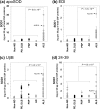Wild-type Cu/Zn-superoxide dismutase is misfolded in cerebrospinal fluid of sporadic amyotrophic lateral sclerosis
- PMID: 31744522
- PMCID: PMC6862823
- DOI: 10.1186/s13024-019-0341-5
Wild-type Cu/Zn-superoxide dismutase is misfolded in cerebrospinal fluid of sporadic amyotrophic lateral sclerosis
Abstract
Background: A subset of familial forms of amyotrophic lateral sclerosis (ALS) are caused by mutations in the gene coding Cu/Zn-superoxide dismutase (SOD1). Mutant SOD1 proteins are susceptible to misfolding and abnormally accumulated in spinal cord, which is most severely affected in ALS. It, however, remains quite controversial whether misfolding of wild-type SOD1 is involved in more prevalent sporadic ALS (sALS) cases without SOD1 mutations.
Methods: Cerebrospinal fluid (CSF) from patients including sALS as well as several other neurodegenerative diseases and non-neurodegenerative diseases was examined with an immunoprecipitation assay and a sandwich ELISA using antibodies specifically recognizing misfolded SOD1.
Results: We found that wild-type SOD1 was misfolded in CSF from all sALS cases examined in this study. The misfolded SOD1 was also detected in CSF from a subset of Parkinson's disease and progressive supranuclear palsy, albeit with smaller amounts than those in sALS. Furthermore, the CSF samples containing the misfolded SOD1 exhibited significant toxicity toward motor neuron-like NSC-34 cells, which was ameliorated by removal of the misfolded wild-type SOD1 with immunoprecipitation.
Conclusions: Taken together, we propose that misfolding of wild-type SOD1 in CSF is a common pathological process of ALS cases regardless of SOD1 mutations.
Keywords: Amyotrophic lateral sclerosis (ALS); Cerebrospinal fluid (CSF); Cu/Zn-superoxide dismutase (SOD1); Protein misfolding.
Conflict of interest statement
The authors declare that they have no competing interests.
Figures









References
-
- Rosen DR, Siddique T, Patterson D, Figlewicz DA, Sapp P, Hentati A, et al. Mutations in Cu/Zn superoxide dismutase gene are associated with familial amyotrophic lateral sclerosis. Nature. 1993;362:59–62. - PubMed
Publication types
MeSH terms
Substances
LinkOut - more resources
Full Text Sources
Other Literature Sources
Medical
Miscellaneous

